
|
Now it is bright as 9.3 mag (Sept. 10, Osamu Miyazaki). It is observable at 8 mag for a long time from 2022 to 2023. In the Northern Hemisphere, it will be unobservable in mid September. Then it is not observable at the high light until 2023 summer. In the Southern Hemisphere, it stays observable for a long time.
Date(TT) R.A. (2000) Decl. Delta r Elong. m1 Best Time(A, h)
Sept.17 15 54.78 -28 16.2 2.298 2.152 68 8.3 19:29 ( 43, 11)
Sept.24 15 55.74 -30 33.3 2.362 2.105 63 8.3 19:18 ( 44, 7)
|
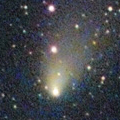
|
It brightened up to 10.4 mag from June to July (July 22, Ken-ichi Kadota). Now it is not observable. In the Souther Hemisphere, it will appear in the morning sky at 12 mag in October. It will never be observable again in the Northern Hemisphere.
Date(TT) R.A. (2000) Decl. Delta r Elong. m1 Best Time(A, h)
Sept.17 11 47.99 -23 9.5 2.169 1.337 25 10.9 19:29 ( 81,-30)
Sept.24 12 4.53 -27 55.4 2.212 1.403 27 11.2 19:18 ( 76,-32)
|
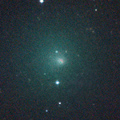
|
Bright new comet. Now it is very bright as 11.6 mag (Sept. 6, Ken Harikae). It stays 11-12 mag until November. In the Southern Hemisphere, it stays observable in good condition for a while. In the Northern Hemisphere, it becomes low rapidly.
Date(TT) R.A. (2000) Decl. Delta r Elong. m1 Best Time(A, h)
Sept.17 1 17.22 -16 5.4 0.898 1.847 151 11.8 1:37 ( 0, 39)
Sept.24 0 27.61 -25 53.0 0.851 1.804 153 11.5 0:21 ( 0, 30)
|
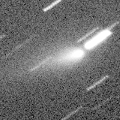
|
Now it is 12.2 mag (Aug. 20, Chris Wyatt). It stays 11-12 mag to autumn. It stays observable in good condition in the Southern Hemisphere. In the Northern Hemisphere, it becomes extremely low from August to September. Michael Jager detected several fragments at 17.5-19 mag.
Date(TT) R.A. (2000) Decl. Delta r Elong. m1 Best Time(A, h)
Sept.17 15 24.82 -27 46.2 0.969 1.024 62 11.6 19:29 ( 48, 7)
Sept.24 16 4.55 -31 12.4 0.966 1.059 65 11.8 19:18 ( 42, 8)
|
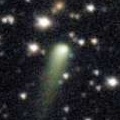
|
Now it is bright as 12.0 mag (Aug. 30, Michael Jager). It will approach to Earth down to 0.29 a.u. in 2023 February, and it is expected to brighten up to 5 mag. In the Northern Hemisphere, it stays observable in excellent condition. In the Southern Hemisphere, it becomes unobservable from late September to early February.
Date(TT) R.A. (2000) Decl. Delta r Elong. m1 Best Time(A, h)
Sept.17 16 6.42 30 3.4 2.235 2.100 69 12.0 19:29 ( 96, 50)
Sept.24 16 0.74 28 57.4 2.250 2.020 63 11.8 19:18 ( 97, 45)
|

|
It brightened up to 8.3 mag in winter (Jan. 6, Toshiyuki Takahashi). Now it is fading. It has already faded down to 13.3 mag (Sept. 4, N. Paul, B. Lutkenhoner, E. Cortes). Appering in the morning sky.
Date(TT) R.A. (2000) Decl. Delta r Elong. m1 Best Time(A, h)
Sept.17 9 20.80 -8 33.9 4.982 4.207 35 11.9 4:18 (283, 3)
Sept.24 9 26.57 -9 59.0 4.961 4.240 39 11.9 4:24 (288, 8)
|
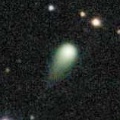
|
Now it is 12.9 mag (Sept. 6, Ken Harikae). It is expected to brighten up to 10 mag in 2023. In the Northern Hemisphere, it stays observable in good condition until 2023 autumn, although it became very low temporarily in summer. In the Southern Hemipshere, it stays unobservable until 2023 summer.
Date(TT) R.A. (2000) Decl. Delta r Elong. m1 Best Time(A, h)
Sept.17 10 34.94 53 14.5 3.924 3.405 52 12.3 4:18 (220, 23)
Sept.24 10 40.17 53 45.1 3.796 3.351 56 12.1 4:24 (222, 27)
|

|
The condition is worst in this apparition. It is not observable at all.
Date(TT) R.A. (2000) Decl. Delta r Elong. m1 Best Time(A, h)
Sept.17 12 46.60 -0 6.6 1.965 1.051 17 12.2 19:29 ( 93, -5)
Sept.24 13 15.18 -2 47.2 1.964 1.060 18 12.3 19:18 ( 89, -5)
|
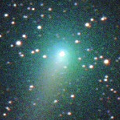
|
It brightened up to 9.3 mag in early summer (June 5, Chris Wyatt). Now it is fading. It has already faded down to 12.8 mag (Aug. 20, Chris Wyatt). In the Southen Hemisphere, it stays observable in good condition for a long time, although it became temporarily low in August. In the Northern Hemisphere, it is not observable until November when it fades down to 13 mag.
Date(TT) R.A. (2000) Decl. Delta r Elong. m1 Best Time(A, h)
Sept.17 10 8.86 -39 6.3 2.731 2.162 46 12.2 4:18 (303,-23)
Sept.24 10 11.25 -39 8.4 2.780 2.212 46 12.4 4:24 (306,-17)
|
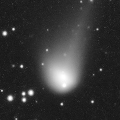
|
Now it is bright as 12.8 mag (Aug. 28, Hiroshi Abe). It stays 12 mag for a while. It becomes unobservable from August to November in the Northern Hemisphere, or from September to December in the Southern Hemisphere.
Date(TT) R.A. (2000) Decl. Delta r Elong. m1 Best Time(A, h)
Sept.17 13 15.10 -2 58.1 5.213 4.323 25 12.5 19:29 ( 87, -1)
Sept.24 13 22.63 -3 0.0 5.262 4.335 20 12.6 19:18 ( 89, -3)
|

|
Appearing in the morning sky in the Northern Hemisphere. It will appear in the morning sky in November also in the Southern Hemisphere. It will brighten up to 11.5 mag in winter
Date(TT) R.A. (2000) Decl. Delta r Elong. m1 Best Time(A, h)
Sept.17 9 45.14 13 12.2 2.626 1.822 29 12.7 4:18 (261, 11)
Sept.24 10 3.25 11 44.7 2.563 1.791 31 12.6 4:24 (265, 13)
|

|
Now it is 12.2 mag (Sept. 16, Osamu Miyazaki). It is expected to brighten up to 11 mag in 2023. In the Northern Hemisphere, it stays observable in good condition until November. But it becomes unobservable after that. In the Southern Hemisphere, it stays observable in good condition for a long time, although it becomes unobservable temporarily from November to January.
Date(TT) R.A. (2000) Decl. Delta r Elong. m1 Best Time(A, h)
Sept.17 17 15.09 -4 36.1 3.768 3.809 84 13.3 19:29 ( 41, 41)
Sept.24 17 15.58 -6 20.4 3.843 3.771 78 13.3 19:18 ( 44, 38)
|
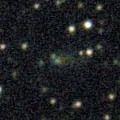
|
Now it is 16.1 mag (Aug. 31, Ken-ichi Kadota). It is expected to brighten very rapidly up to 11-12 mag in winter, and it will be observable in excellent condition.
Date(TT) R.A. (2000) Decl. Delta r Elong. m1 Best Time(A, h)
Sept.17 6 26.61 13 11.4 1.868 1.919 77 13.8 4:18 (294, 51)
Sept.24 6 41.61 12 46.0 1.790 1.902 80 13.5 4:24 (300, 54)
|
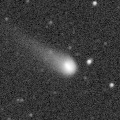
|
Now it is 13.6 mag (Aug. 28, Hiroshi Abe). It is expected to brighten up to 12 mag in 2023. In the Northern Hemisphere, it stays observable in good condition for a long time, although it becomes unobservable temporarily in October. In the Southern Hemisphere, it is not observable until mid December. But it will be observable in good condition in 2023.
Date(TT) R.A. (2000) Decl. Delta r Elong. m1 Best Time(A, h)
Sept.17 13 28.41 18 46.6 4.839 4.019 31 13.6 19:29 (103, 13)
Sept.24 13 30.22 17 26.3 4.851 3.993 27 13.5 19:18 (104, 10)
|
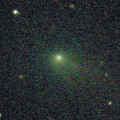
|
Now it is 13.7 mag (Sept. 2, Michael Jager). It stays observable in good condition after this. But it will be fading gradually after this.
Date(TT) R.A. (2000) Decl. Delta r Elong. m1 Best Time(A, h)
Sept.17 1 31.02 1 32.1 1.386 2.318 151 13.7 1:49 ( 0, 57)
Sept.24 1 25.28 0 46.2 1.396 2.361 159 13.9 1:16 ( 0, 56)
|

|
Now it is 13.9 mag (Sept. 6. Ken-ichi Kadota).
Date(TT) R.A. (2000) Decl. Delta r Elong. m1 Best Time(A, h)
Sept.17 6 48.46 28 57.4 6.237 6.024 73 13.8 4:18 (268, 54)
Sept.24 6 51.62 28 56.7 6.131 6.026 79 13.8 4:24 (272, 60)
|

|
Now it is 13.7 mag (Aug. 19, Ken-ichi Kadota). It stays observable at 13-14 mag for a while.
Date(TT) R.A. (2000) Decl. Delta r Elong. m1 Best Time(A, h)
Sept.17 18 34.82 -31 39.8 2.664 3.060 103 13.9 19:29 ( 9, 23)
Sept.24 18 40.00 -31 25.9 2.761 3.064 97 14.0 19:18 ( 12, 23)
|

|
Now it is 14.0 mag (Aug. 20, Chris Wyatt). The brightness evolution is slower than originally expected. It stays 14-15 mag for a long time. It locates extremely low in the Northern Hemisphere. In the Southern Hemisphere, it will be unobservable temporarily in November.
Date(TT) R.A. (2000) Decl. Delta r Elong. m1 Best Time(A, h)
Sept.17 16 41.97 -33 8.1 2.962 2.956 79 14.2 19:29 ( 32, 13)
Sept.24 16 42.95 -31 2.1 3.091 2.957 72 14.3 19:18 ( 36, 13)
|
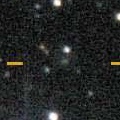
|
Now it is 16.1 mag (Sept. 1, D. Buczynski). It is expected to brighten up to 12 mag from winter to summer in 2023. In the Northern Hemisphere, it stays observable in good condition until 2023 spring. In the Southern Hemisphere, it stays observable in good condition for a long time after this.
Date(TT) R.A. (2000) Decl. Delta r Elong. m1 Best Time(A, h)
Sept.17 5 14.81 34 1.9 3.075 3.288 93 14.6 4:18 (268, 75)
Sept.24 5 16.49 33 4.2 2.906 3.230 99 14.4 4:24 (279, 81)
|
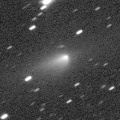
|
Now it is 13.8 mag (Aug. 20, Chris Wyatt). It is already unobservable in the Northern Hemisphere. It will be unobservable in late September also in the Southern Hemisphere.
Date(TT) R.A. (2000) Decl. Delta r Elong. m1 Best Time(A, h)
Sept.17 13 24.88 -9 39.2 3.060 2.240 29 14.7 19:29 ( 80, -3)
Sept.24 13 38.79 -11 6.2 3.105 2.250 26 14.8 19:18 ( 79, -5)
|

|
Now it is 14.9 mag (Sept. 4, ATLAS South Africa). It was expected to brighten up to 13 mag in spring. But actually, it is fainter than originally expected. In the Southern Hemisphere, it stays observable in good condition for a long time. In the Northern Hemisphere, it stays extremely low for a while.
Date(TT) R.A. (2000) Decl. Delta r Elong. m1 Best Time(A, h)
Sept.17 6 35.53 -46 4.7 3.243 3.255 81 15.2 4:18 (334, 2)
Sept.24 6 28.36 -47 29.1 3.197 3.273 85 15.2 4:24 (341, 4)
|
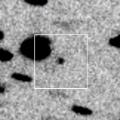
|
Now it is 14.2 mag (Aug. 17, Thomas Lehmann). Now it is fading. It stays 13-14 mag for a while. It is observable in excellent condition in the Southern Hemisphere. It locates somewhat low in the Northern Hemisphere.
Date(TT) R.A. (2000) Decl. Delta r Elong. m1 Best Time(A, h)
Sept.17 22 25.31 -28 36.0 1.423 2.342 148 15.2 22:40 ( 0, 27)
Sept.24 22 21.13 -28 13.6 1.505 2.382 142 15.4 22:08 ( 0, 27)
|
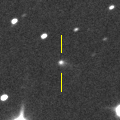
|
Now it is 15.8 mag (Aug. 31, Ken-ichi Kadota). It will brighten up to 14 mag in early 2023, and it will be observable in good condition.
Date(TT) R.A. (2000) Decl. Delta r Elong. m1 Best Time(A, h)
Sept.17 8 10.00 16 54.6 4.149 3.631 52 15.5 4:18 (271, 32)
Sept.24 8 18.93 16 48.0 4.045 3.608 57 15.4 4:24 (275, 37)
|
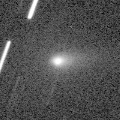
|
Now it is 14.2 mag (Sept. 6, Michael Jager). It brightened rapidly as predicted. It stays observable at 14-15 mag in good condition in September.
Date(TT) R.A. (2000) Decl. Delta r Elong. m1 Best Time(A, h)
Sept.17 2 5.18 -9 31.0 0.641 1.563 142 15.4 2:23 ( 0, 46)
Sept.24 2 11.01 -16 6.7 0.644 1.572 144 15.5 2:01 ( 0, 39)
|
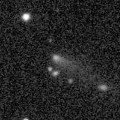
|
Now it is 15.3 mag (Sept. 6, Ken-ichi Kadota). It stays 15 mag and observable in excellent condition until December.
Date(TT) R.A. (2000) Decl. Delta r Elong. m1 Best Time(A, h)
Sept.17 2 51.76 14 16.6 1.689 2.449 128 15.5 3:10 ( 0, 69)
Sept.24 2 51.29 15 29.0 1.620 2.440 135 15.4 2:42 ( 0, 71)
|

|
It has not been observed yet in this apparition. It will brighten very rapidly, and it is expected to brighten up to 15 mag in September. It is not observable in the Southern Hemisphere. It locates extremely low even in the Northern Hemisphere.
Date(TT) R.A. (2000) Decl. Delta r Elong. m1 Best Time(A, h)
Sept.17 9 55.70 9 54.2 1.639 0.861 26 15.5 4:18 (263, 7)
Sept.24 10 24.98 5 53.9 1.687 0.887 25 16.0 4:24 (267, 5)
|
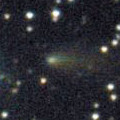
|
Now it is 15.0 mag (Sept. 1, ATLAS-MLO, Mauna Loa). It stays observable in good condition at 15 mag from summer to winter. It locates somwwhat low in the Southern Hemisphere.
Date(TT) R.A. (2000) Decl. Delta r Elong. m1 Best Time(A, h)
Sept.17 6 53.41 19 45.6 2.462 2.341 71 15.6 4:18 (280, 49)
Sept.24 7 4.83 19 38.6 2.390 2.347 75 15.6 4:24 (285, 53)
|
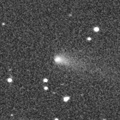
|
Now it is 15.6 mag (Sept. 6, Ken-ichi Kadota). It stays 15.5 mag until November, and it stays observable in good condition.
Date(TT) R.A. (2000) Decl. Delta r Elong. m1 Best Time(A, h)
Sept.17 1 37.83 4 54.3 1.220 2.145 148 15.7 1:56 ( 0, 60)
Sept.24 1 36.71 4 10.7 1.182 2.138 156 15.7 1:27 ( 0, 59)
|
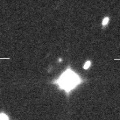
|
It is expected to brighten up to 12.5 mag in winter. In the Northern Hemisphere, it will become observable in October. Then it stays observable in good condition after that. In the Southern Hemisphere, it is not observable until 2023 June.
Date(TT) R.A. (2000) Decl. Delta r Elong. m1 Best Time(A, h)
Sept.17 11 36.19 16 4.7 3.563 2.597 13 15.9 4:18 (243, -9)
Sept.24 11 44.32 16 40.0 3.475 2.536 17 15.7 4:24 (246, -4)
|

|
Now it is 16.5 mag (Aug. 17, Thomas Lehmann). It stays at 15-16 mag for a long time. In the Southern Hemisphere, it stays observable in excellent condition for a long time, although it becomes extremely low temporarily in November. In the Northern Hemiphere, it is not observable after this.
Date(TT) R.A. (2000) Decl. Delta r Elong. m1 Best Time(A, h)
Sept.17 14 25.12 -49 7.8 5.934 5.551 63 15.8 19:29 ( 40,-16)
Sept.24 14 27.21 -49 22.1 6.039 5.574 58 15.9 19:18 ( 41,-18)
|
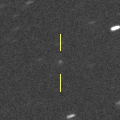
|
It will brighten up to 13 mag in winter. But the condition is bad. It is not observable until February in the Southern Hemisphere, or until May in the Northern Hemisphere.
Date(TT) R.A. (2000) Decl. Delta r Elong. m1 Best Time(A, h)
Sept.17 12 54.43 -1 38.9 2.892 1.975 19 16.1 19:29 ( 91, -5)
Sept.24 13 8.80 -3 28.1 2.878 1.940 16 15.9 19:18 ( 90, -6)
|
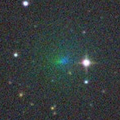
|
Brightened rapidly. Now it is very bright as 14.0 mag (Sept. 2, Michael Jager). It will be fading after this. In the Northern Hemisphere, it stays observable for a long time, although it becomes extremely low in November. In the Southern Hemisphere, it becomes unobservable in late September.
Date(TT) R.A. (2000) Decl. Delta r Elong. m1 Best Time(A, h)
Sept.17 15 27.87 16 26.6 1.878 1.599 58 15.9 19:29 ( 85, 36)
Sept.24 15 23.48 16 38.4 1.993 1.593 52 16.0 19:18 ( 88, 32)
|
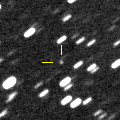
|
Now it is 15.5 mag (Sept. 8, ATLAS-MLO, Mauna Loa). It will brighten up to 14 mag in 2023. In the Southern Hemisphere, it stays observable in good condition for a long time. It locates somewhat low in the Northern Hemisphere.
Date(TT) R.A. (2000) Decl. Delta r Elong. m1 Best Time(A, h)
Sept.17 6 40.11 -14 16.4 4.141 4.007 75 16.1 4:18 (315, 28)
Sept.24 6 37.62 -15 13.0 3.994 3.970 81 16.0 4:24 (324, 32)
|
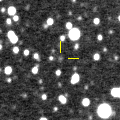
|
Now it is 16.8 mag (June 1, ATLAS South Africa). It will brighten up to 13 mag from 2024 to 2025.
Date(TT) R.A. (2000) Decl. Delta r Elong. m1 Best Time(A, h)
Sept.17 8 44.80 -27 38.8 7.903 7.316 51 16.2 4:18 (303, -2)
Sept.24 8 49.10 -28 17.3 7.825 7.280 53 16.2 4:24 (308, 3)
|
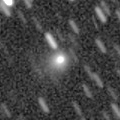
|
It brightened by 6 mag in outburst up to 14.6 mag (Aug. 13, ATLAS-MLO, Mauna Loa). Now it is fading. But it is bright as 15.5 mag still now (Sept. 4, ATLAS-MLO, Mauna Loa). It stays observable in good condition for a while.
Date(TT) R.A. (2000) Decl. Delta r Elong. m1 Best Time(A, h)
Sept.17 18 33.82 4 55.5 1.599 2.083 103 16.2 19:29 ( 19, 58)
Sept.24 18 40.43 3 9.5 1.624 2.046 99 16.5 19:18 ( 23, 56)
|
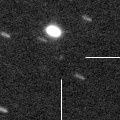
|
Now it is 16.2 mag (Sept. 8, ATLAS-MLO, Mauna Loa). It is expected to brighten up to 8 mag in 2023 July. In 2022, it stays observable in good condition while the comet will be brightening gradually.
Date(TT) R.A. (2000) Decl. Delta r Elong. m1 Best Time(A, h)
Sept.17 3 18.61 2 10.5 3.489 4.141 124 16.4 3:37 ( 0, 57)
Sept.24 3 12.00 0 57.9 3.328 4.074 132 16.2 3:03 ( 0, 56)
|
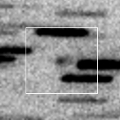
|
Now it is 16.1 mag (Sept. 6, Ken-ichi Kadota). It stays observable at 16 mag from summer to winter. In the Southern Hemisphere, it locates low until October.
Date(TT) R.A. (2000) Decl. Delta r Elong. m1 Best Time(A, h)
Sept.17 8 7.98 23 48.0 1.922 1.574 54 16.4 4:18 (264, 36)
Sept.24 8 27.94 22 3.0 1.888 1.579 56 16.4 4:24 (268, 38)
|
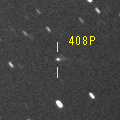
|
Now it is 16.8 mag (Sept. 8, ATLAS-MLO, Mauna Loa). It will be observable at 16-17 mag in excellent condition from autumn to winter.
Date(TT) R.A. (2000) Decl. Delta r Elong. m1 Best Time(A, h)
Sept.17 4 33.52 6 51.0 3.062 3.469 105 16.4 4:18 (343, 61)
Sept.24 4 36.12 6 8.1 2.973 3.468 111 16.4 4:24 (359, 61)
|
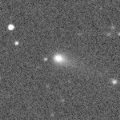
|
Now it is 15.9 mag (Sept. 5, Michael Jager). It continued brightening even after the perihelion passage. It stays observable at 16 mag in good condition for a while.
Date(TT) R.A. (2000) Decl. Delta r Elong. m1 Best Time(A, h)
Sept.17 23 9.09 -1 40.5 3.285 4.285 172 16.4 23:23 ( 0, 53)
Sept.24 23 5.93 -2 4.5 3.316 4.296 165 16.5 22:53 ( 0, 53)
|

|
It brightened up to 14 mag in 2021. Now it is fading. It has already faded down to 16.1 mag (Sept. 8, ATLAS-MLO, Mauna Loa). It is observable at 16-17 mag in 2022.
Date(TT) R.A. (2000) Decl. Delta r Elong. m1 Best Time(A, h)
Sept.17 23 44.28 15 9.8 5.157 6.122 162 16.4 0:03 ( 0, 70)
Sept.24 23 39.95 15 14.3 5.189 6.160 164 16.5 23:27 ( 0, 70)
|
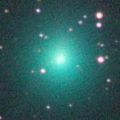
|
It brightened up to 9.3 mag from spring to early summer (Mar. 24, Michael Jager). It stayed bright for a while even after the perihelion passaage. But it is fading rapidly now. It has already faded down to 17.1 mag (Aug. 9, iTelescope Observatory, Siding Spring). In the Southern Hemisphere, it stays observable in good condition for a long time. In the Northern Hemisphere, it will never be observable again.
Date(TT) R.A. (2000) Decl. Delta r Elong. m1 Best Time(A, h)
Sept.17 5 35.95 -72 5.8 2.397 2.639 92 16.5 4:18 (353,-18)
Sept.24 5 40.52 -75 34.5 2.510 2.721 91 16.9 4:24 (356,-21)
|

|
Now it is 15.6 mag (Sept. 8, ATLAS-MLO, Mauna Loa). It brightened up to 14 mag from 2020 to 2021. Now it is fading slowly. It is observable at 16-17 mag in 2022.
Date(TT) R.A. (2000) Decl. Delta r Elong. m1 Best Time(A, h)
Sept.17 0 35.68 -19 3.9 2.992 3.943 158 16.5 0:54 ( 0, 36)
Sept.24 0 31.04 -19 30.0 3.007 3.960 159 16.6 0:22 ( 0, 36)
|
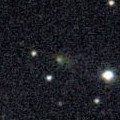
|
Now it is 16.7 mag (Aug. 21, Ken-ichi Kadota). It will be observable at 16.5 mag in good condition from summer to autumn.
Date(TT) R.A. (2000) Decl. Delta r Elong. m1 Best Time(A, h)
Sept.17 3 39.91 27 10.0 1.785 2.385 114 16.6 3:58 ( 0, 82)
Sept.24 3 41.75 27 27.1 1.735 2.409 120 16.6 3:32 ( 0, 83)
|
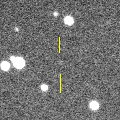
|
Now it is 16.6 mag (Aug. 28, ATLAS South Africa). It is expected to brighten up to 7 mag in early 2024. In the Southern Hemisphere, it stays observable in good condition for a long time. In the Northern Hemisphere, it stays low in 2022.
Date(TT) R.A. (2000) Decl. Delta r Elong. m1 Best Time(A, h)
Sept.17 6 15.72 -25 20.6 6.082 6.031 82 16.7 4:18 (327, 22)
Sept.24 6 17.85 -26 20.7 5.948 5.970 86 16.6 4:24 (335, 24)
|
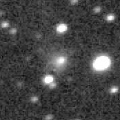
|
Now it is 16.6 mag (Aug. 31, ATLAS-MLO, Mauna Loa). It stayed bright for a while even after the perihelion passage, but it will be fading after this. It will be fainter than 18 mag in winter.
Date(TT) R.A. (2000) Decl. Delta r Elong. m1 Best Time(A, h)
Sept.17 21 28.95 5 25.4 6.249 7.114 147 16.8 21:44 ( 0, 60)
Sept.24 21 25.31 4 25.2 6.336 7.140 140 16.9 21:12 ( 0, 59)
|

|
It brightened up to 14.2 mag in 2021 summer (July 18, 2021, Taras Prystavski). Now it is fading. It has already faded down to 16.4 mag (Sept. 3, ATLAS Chile). In the Southern Hemisphere, it stays observable in good condition for a long time. It locates somewhat low in the Northern Hemisphere.
Date(TT) R.A. (2000) Decl. Delta r Elong. m1 Best Time(A, h)
Sept.17 2 7.08 -26 53.8 4.556 5.331 136 16.9 2:25 ( 0, 28)
Sept.24 2 2.55 -27 0.5 4.563 5.373 140 16.9 1:53 ( 0, 28)
|
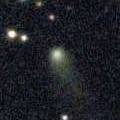
|
Now it is 16.2 mag (Aug. 21, Thomas Lehmann). It stays observable at 16 mag from 2021 to 2022. It locates low in the Southern Hemisphere.
Date(TT) R.A. (2000) Decl. Delta r Elong. m1 Best Time(A, h)
Sept.17 15 42.11 39 7.5 5.770 5.447 66 16.9 19:29 (112, 48)
Sept.24 15 47.08 38 45.3 5.831 5.474 64 17.0 19:18 (112, 46)
|

|
Now it is 16.5 mag (Sept. 7, ATLAS-MLO, Mauna Loa). Fading slowly. In the Northern Hemisphere, it stays observable in good condition for a long time. In the Southern Hemisphere, it is not observable after this.
Date(TT) R.A. (2000) Decl. Delta r Elong. m1 Best Time(A, h)
Sept.17 17 9.59 65 31.9 9.424 9.388 84 17.0 19:29 (158, 54)
Sept.24 17 8.77 65 3.5 9.443 9.402 84 17.0 19:18 (156, 53)
|
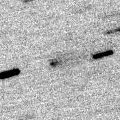
|
Now it is 16.9 mag (Aug. 31, Michael Jager). It stays observable at 17 mag until winter. In the Southern Hemisphere, it locates extremely low until autumn.
Date(TT) R.A. (2000) Decl. Delta r Elong. m1 Best Time(A, h)
Sept.17 8 14.96 22 13.1 2.534 2.087 52 17.2 4:18 (265, 34)
Sept.24 8 29.04 20 59.7 2.493 2.107 56 17.2 4:24 (269, 37)
|
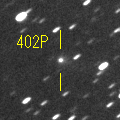
|
It brightened up to 15.3 mag in last winter (Jan. 12, H. Nohara). Now it is fading. It will be observable at 17 mag in good condition in next winter. It locates somewhat low in the Southern Hemisphere.
Date(TT) R.A. (2000) Decl. Delta r Elong. m1 Best Time(A, h)
Sept.17 9 20.98 18 28.1 4.997 4.237 36 17.3 4:18 (260, 18)
Sept.24 9 28.35 18 21.7 4.942 4.251 42 17.3 4:24 (264, 24)
|

|
Now it is 17.7 mag (Aug. 27, ATLAS-HKO, Haleakala). It stays observable at 17-18 mag in 2022. It locates somewhat low in the Southern Hemisphere.
Date(TT) R.A. (2000) Decl. Delta r Elong. m1 Best Time(A, h)
Sept.17 2 11.01 29 4.9 4.769 5.487 131 17.4 2:30 ( 0, 84)
Sept.24 2 2.14 28 39.2 4.695 5.499 139 17.4 1:53 ( 0, 84)
|
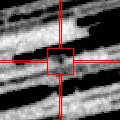
|
Now it is 17.3 mag (Aug. 29, ATLAS-MLO, Mauna Loa). It is expected to brighten up to 11-12 mag in 2024. In the Northern Hemisphere, it stays observable in good condition for a long time until 2023 autumn, although it becomes temporarily low in December. In the Southern Hemisphere, it becomes unobservable in October. But it will be observable in excellent condition at the high light.
Date(TT) R.A. (2000) Decl. Delta r Elong. m1 Best Time(A, h)
Sept.17 18 1.15 26 33.7 5.657 5.818 94 17.4 19:29 ( 67, 72)
Sept.24 17 58.72 25 24.3 5.691 5.766 89 17.4 19:18 ( 70, 68)
|
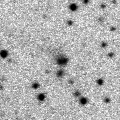
|
Now it is 17.3 mag (Aug. 18, Michael Jager). It started fading before the perihelion passage. It was predicted to stay at 16 mag for a long time. But actually, it will be fainter than 18 mag in autumn. In the Northern Hemisphere, it stays observable in good condition for a long time. In the Southern Hemisphere, it is not observable until 2023.
Date(TT) R.A. (2000) Decl. Delta r Elong. m1 Best Time(A, h)
Sept.17 17 26.70 58 45.0 3.892 3.960 86 17.4 19:29 (151, 60)
Sept.24 17 31.74 55 53.8 3.923 3.980 85 17.4 19:18 (145, 61)
|

|
It brightened very rapidly up to 15.5 mag from last autumn to last winter (Nov. 2, 2021, Toshihiko Ikemura, Hirohisa Sato). Now it is fading. It has already faded down to 17.0 mag (Apr. 2, Palomar Mountain--ZTF).
Date(TT) R.A. (2000) Decl. Delta r Elong. m1 Best Time(A, h)
Sept.17 6 32.85 14 32.2 4.328 4.198 75 17.4 4:18 (291, 50)
Sept.24 6 37.32 14 6.6 4.243 4.215 81 17.4 4:24 (299, 55)
|
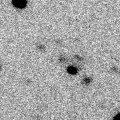
|
Now it is 17.2 mag (Aug. 15, Ken-ichi Kadota). In the Northern Hemisphere, it stays observable at 17 mag in good condition for a long time until winter. In the Southern Hemisphere, it stays extremely low for a long time.
Date(TT) R.A. (2000) Decl. Delta r Elong. m1 Best Time(A, h)
Sept.17 6 48.60 45 5.7 2.869 2.796 75 17.5 4:18 (239, 57)
Sept.24 7 2.31 45 32.9 2.805 2.806 79 17.5 4:24 (238, 60)
|
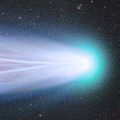
|
It brightened up to 3 mag from mid December to late December. Now it is fading. It is observable in good condition in the Southern Hemisphere. No observations have been reported since June.
Date(TT) R.A. (2000) Decl. Delta r Elong. m1 Best Time(A, h)
Sept.17 16 3.28 -21 50.9 4.162 3.921 69 17.5 19:29 ( 46, 17)
Sept.24 16 6.20 -21 37.1 4.353 4.000 63 17.7 19:18 ( 49, 15)
|
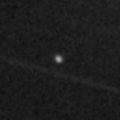
|
Now it is 17.4 mag (Aug. 9, Michael Jager). In 2022, it stays observable at 17 mag for a long time.
Date(TT) R.A. (2000) Decl. Delta r Elong. m1 Best Time(A, h)
Sept.17 6 53.06 26 23.7 0.665 1.019 71 17.6 4:18 (271, 52)
Sept.24 7 13.80 25 27.1 0.698 1.053 74 17.7 4:24 (275, 55)
|
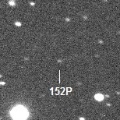
|
Now it is 17.9 mag (Sept. 2, J. Drummond). It will be fading gradually after this. It locates somewhat low in the Northern Hemisphere.
Date(TT) R.A. (2000) Decl. Delta r Elong. m1 Best Time(A, h)
Sept.17 19 20.35 -28 26.8 2.826 3.359 113 17.6 19:36 ( 0, 27)
Sept.24 19 23.15 -28 21.9 2.931 3.373 107 17.7 19:18 ( 2, 27)
|
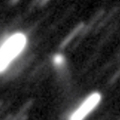
|
Now it is 16.9 mag (Aug. 23, Thomas Lehmann). It was observed at 15 mag in 2021. Now it is fading. It stays observable at 16-17 mag for a while in 2022.
Date(TT) R.A. (2000) Decl. Delta r Elong. m1 Best Time(A, h)
Sept.17 17 44.98 29 7.5 5.593 5.692 90 17.6 19:29 ( 79, 70)
Sept.24 17 46.35 28 47.4 5.690 5.719 86 17.7 19:18 ( 82, 67)
|

|
It approached to Sun down to 0.14 a.u. on May 15. But it was not observable around that time. In the Northern Hemisphere, it stays observable at 17-18 mag in good condition from July to November. In the Southern Hemisphere, it stays extremely low.
Date(TT) R.A. (2000) Decl. Delta r Elong. m1 Best Time(A, h)
Sept.17 3 58.12 45 1.3 1.422 1.947 105 17.8 4:17 (180, 80)
Sept.24 3 46.89 45 45.4 1.376 1.995 113 17.7 3:38 (180, 79)
|
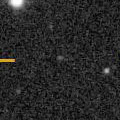
|
Now it is 17.5 mag (Sept. 5, Purple Mountain Observatory, XuYi Station). It stays observable at 18 mag in good condition from August to September.
Date(TT) R.A. (2000) Decl. Delta r Elong. m1 Best Time(A, h)
Sept.17 23 43.21 -9 6.8 1.333 2.335 173 17.8 0:02 ( 0, 46)
Sept.24 23 39.05 -9 7.2 1.348 2.341 168 17.8 23:26 ( 0, 46)
|

|
Now it is 18.3 mag (Sept. 6, M. Urbanik). It stays observable at 17-18 mag until next summer.
Date(TT) R.A. (2000) Decl. Delta r Elong. m1 Best Time(A, h)
Sept.17 2 13.58 -5 46.1 1.509 2.375 140 18.1 2:33 ( 0, 49)
Sept.24 1 46.56 -7 51.9 1.378 2.316 152 17.8 1:38 ( 0, 47)
|

|
Now it is 17.5 mag (Aug. 25, C. Gerhard). In the Northern Hemisphere, it is observable at 17-18 mag in excellent condition in autumn. In the Southern Hemisphere, it is only observable in extremely low sky in September.
Date(TT) R.A. (2000) Decl. Delta r Elong. m1 Best Time(A, h)
Sept.17 7 4.33 36 47.3 2.766 2.620 71 17.9 4:18 (254, 53)
Sept.24 7 14.96 38 54.9 2.691 2.637 76 17.9 4:24 (251, 58)
|
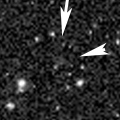
|
Now it is 17.3 mag (June 27, ATLAS South Africa). Very far object. It stays 18 mag for a long time from 2021 to 2026. In the Southern Hemisphere, it stays observable in good condition for a long time. In the Northern Hemisphere, it is not observable at all.
Date(TT) R.A. (2000) Decl. Delta r Elong. m1 Best Time(A, h)
Sept.17 8 18.25 -66 9.6 10.736 10.559 77 17.9 4:18 (337,-22)
Sept.24 8 19.88 -66 53.1 10.732 10.551 76 17.9 4:24 (340,-20)
|
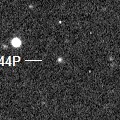
|
It is observable at 17 mag in good condition in winter. It locates somewhat low in the Southern Hemisphere.
Date(TT) R.A. (2000) Decl. Delta r Elong. m1 Best Time(A, h)
Sept.17 6 14.28 25 37.6 3.965 3.928 80 18.0 4:18 (279, 60)
Sept.24 6 19.26 25 39.4 3.861 3.926 86 17.9 4:24 (285, 66)
|
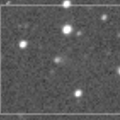
|
It was observed at 17 mag in 2021. It was expected to be observable at 17-18 mag also in 2022. But actually, it is much fainter than last year by 3 mag, 20.3 mag (Sept. 5, W. Hasubick).
Date(TT) R.A. (2000) Decl. Delta r Elong. m1 Best Time(A, h)
Sept.17 2 55.19 12 33.3 2.812 3.528 128 19.6 3:13 ( 0, 68)
Sept.24 2 51.59 13 12.1 2.758 3.550 136 19.7 2:42 ( 0, 68)
|
|
![]()
 C/2021 E3 ( ZTF )
C/2021 E3 ( ZTF ) C/2019 T4 ( ATLAS )
C/2019 T4 ( ATLAS ) 81P/Wild 2
81P/Wild 2 C/2020 K1 ( PanSTARRS )
C/2020 K1 ( PanSTARRS ) 118P/Shoemaker-Levy 4
118P/Shoemaker-Levy 4 C/2019 U5 ( PanSTARRS )
C/2019 U5 ( PanSTARRS ) 22P/Kopff
22P/Kopff 29P/Schwassmann-Wachmann 1
29P/Schwassmann-Wachmann 1 117P/Helin-Roman-Alu 1
117P/Helin-Roman-Alu 1 C/2020 R7 ( ATLAS )
C/2020 R7 ( ATLAS ) C/2021 Y1 ( ATLAS )
C/2021 Y1 ( ATLAS ) 116P/Wild 4
116P/Wild 4 C/2020 Y2 ( ATLAS )
C/2020 Y2 ( ATLAS ) 9P/Tempel 1
9P/Tempel 1 C/2020 S4 ( PanSTARRS )
C/2020 S4 ( PanSTARRS ) 327P/Van Ness
327P/Van Ness P/2022 L3 ( ATLAS )
P/2022 L3 ( ATLAS ) 255P/Levy
255P/Levy 119P/Parker-Hartley
119P/Parker-Hartley 61P/Shajn-Schaldach
61P/Shajn-Schaldach C/2022 A2 ( PanSTARRS )
C/2022 A2 ( PanSTARRS ) C/2018 U1 ( Lemmon )
C/2018 U1 ( Lemmon ) 71P/Clark
71P/Clark C/2022 L1 ( Catalina )
C/2022 L1 ( Catalina ) C/2021 X1 ( Maury-Attard )
C/2021 X1 ( Maury-Attard ) C/2021 G2 ( ATLAS )
C/2021 G2 ( ATLAS ) 285P/LINEAR
285P/LINEAR C/2021 T4 ( Lemmon )
C/2021 T4 ( Lemmon ) 157P/Tritton
157P/Tritton 408P/2020 M7 ( Novichonok-Gerke )
408P/2020 M7 ( Novichonok-Gerke ) 395P/2020 H1 ( Catalina-NEAT )
395P/2020 H1 ( Catalina-NEAT ) C/2020 F5 ( MASTER )
C/2020 F5 ( MASTER ) C/2021 F1 ( Lemmon-PanSTARRS )
C/2021 F1 ( Lemmon-PanSTARRS ) 246P/NEAT
246P/NEAT 44P/Reinmuth 2
44P/Reinmuth 2 C/2021 S3 ( PanSTARRS )
C/2021 S3 ( PanSTARRS ) C/2019 T3 ( ATLAS )
C/2019 T3 ( ATLAS ) C/2019 F1 ( ATLAS-Africano )
C/2019 F1 ( ATLAS-Africano ) C/2020 H6 ( ATLAS )
C/2020 H6 ( ATLAS ) C/2019 O3 ( Palomar )
C/2019 O3 ( Palomar ) P/2022 P2 ( ZTF )
P/2022 P2 ( ZTF ) 402P/2020 Q3 ( LINEAR )
402P/2020 Q3 ( LINEAR ) C/2020 U4 ( PanSTARRS )
C/2020 U4 ( PanSTARRS ) C/2022 L2 ( ATLAS )
C/2022 L2 ( ATLAS ) C/2020 U5 ( PanSTARRS )
C/2020 U5 ( PanSTARRS ) P/2021 N2 ( Fuls )
P/2021 N2 ( Fuls ) C/2021 QM45 ( PanSTARRS )
C/2021 QM45 ( PanSTARRS ) C/2021 A1 ( Leonard )
C/2021 A1 ( Leonard ) 107P/(4015) Wilson-Harrington
107P/(4015) Wilson-Harrington 152P/Helin-Lawrence
152P/Helin-Lawrence C/2020 O2 ( Amaral )
C/2020 O2 ( Amaral ) (3200) Phaethon
(3200) Phaethon 442P/2022 G1 ( McNaught )
442P/2022 G1 ( McNaught ) C/2022 Q2 ( ATLAS )
C/2022 Q2 ( ATLAS ) C/2022 P3 ( ZTF )
C/2022 P3 ( ZTF ) C/2019 E3 ( ATLAS )
C/2019 E3 ( ATLAS ) 244P/Scotti
244P/Scotti 422P/2021 L1 ( Christensen )
422P/2021 L1 ( Christensen )![]()




























































